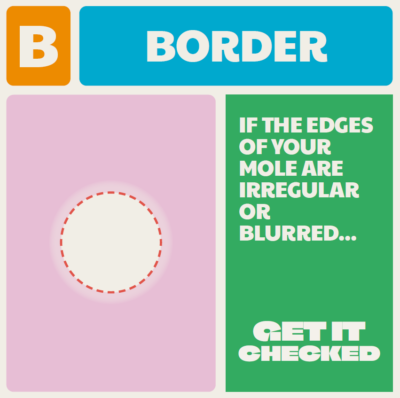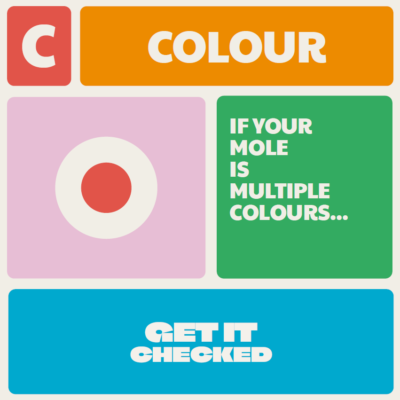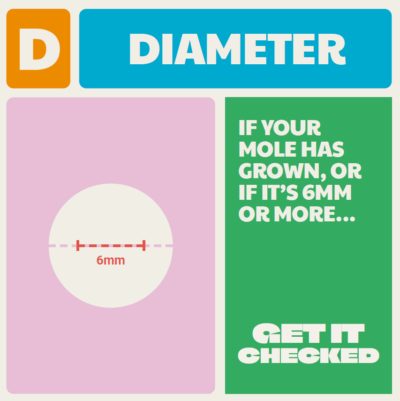
Skin cancer is the UK’s fifth most common cancer, and recent reports show that the number of cases of skin cancer in the UK is increasing rapidly. However, 86% of skin cancers could be prevented, which is why it’s important to be Sun Smart. Find information on this page about how to protect yourself from the sun, as well as symptoms that you should get checked by your GP.
Find out more about:
Keep Safe in the Sun
Even here in Greater Manchester, the sun is strong enough to damage your skin during the summer months. Between March and October, you should look after your skin by taking the following precautions:
- Spend time in the shade between 11am and 3pm
- make sure you never burn
- Cover up with suitable clothing and sunglasses
- Take extra care with children
- Use a ‘high protection’ sunscreen of at least SPF 30 which also has high UVA protection.
Take extra care in the sun if you:
- Have freckles or red or fair hair
- Tend to burn rather than tan
- Have many moles
- Have skin problems relating to a medical condition
- Are only exposed to intense sun occasionally (for example, while on holiday)
- Are in a hot country where the sun is particularly intense
- Have a personal or family history of skin cancer
Take extra care to protect babies and children. Their skin is much more sensitive than adult skin, and damage caused by repeated exposure to sunlight could lead to skin cancer developing in later life.
Sun Safety Poll!

Every day at RHS Tatton Flower Show, we’ll ask visitors to the stand to take part in a poll, testing their sun safety knowledge. If you’re not able to visit us at Tatton, you can take part here.
Follow these steps to apply sunscreen correctly and protect your skin from the sun:
- As a guide, adults should aim to apply around
- 2 teaspoons of sunscreen if you’re just covering your head, arms and neck
- 2 tablespoons of sunscreen if you’re covering your entire body whilst wearing a swimming costume
- If sunscreen is applied too thinly, the amount of protection it gives is reduced.
- If you plan to be out in the sun long enough to risk burning, sunscreen needs to be applied twice: 30 minutes before going out and again just before going out.
- Sunscreen should be applied to all exposed skin, including the face, neck and ears, and head if you have thinning or no hair, but a wide-brimmed hat is better.
- Sunscreen needs to be reapplied liberally and frequently, and according to the manufacturer’s instructions.
- This includes applying it straight after you have been in water, even if it’s “water resistant” and after towel drying, sweating or when it may have rubbed off.
- It’s also recommended to reapply sunscreen every 2 hours, as the sun can dry it off your skin.
Melanoma Skin Cancer
- Melanoma is a type of skin cancer that can spread to other areas of the body.
- The main cause of melanoma is ultraviolet light, which comes from the sun and is used in sunbeds.
- Things that increase your chances of getting melanoma include your age and having pale skin, a large number of moles and a family history of skin cancer.
- It’s often possible to prevent skin cancer by being careful in the sun.
- You can use the ABCDE guide below to remember signs to look out for when checking your skin.

Asymmetry
If the two halves of your mole differ in shape and are not symmetrical.

Border
If the edges of your mole are irregular or blurred.

Colour.
If your mole is made up of different colours.

Diameter
f your mole has grown, or if it is 6mm or wider.

Evolution
If your mole has changed in shape, size or colour.
Non-melanoma Skin Cancer
Non-melanoma skin cancer refers to a group of cancers that slowly develop in the upper layers of the skin. Signs to look out for include:
- A scab or sore that doesn’t heal.
- A scaly or inflammed patch of red skin that doesnt clear up.
- A pearly lump that continues to grow.
- A volcano-like growth with a pearly rim.


